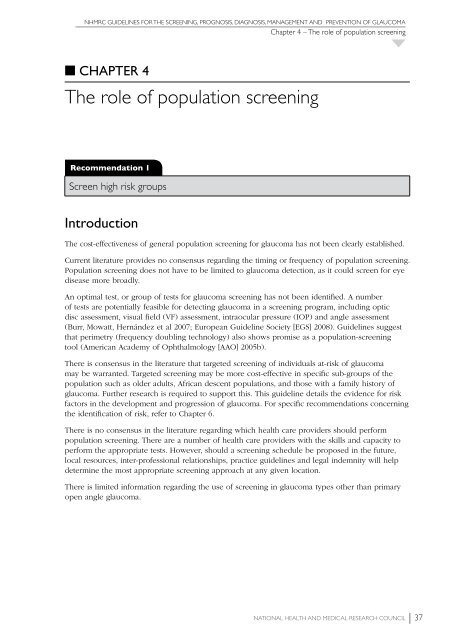NHMRC Glaucoma Guidelines - ANZGIG
NHMRC Glaucoma Guidelines - ANZGIG
NHMRC Glaucoma Guidelines - ANZGIG
You also want an ePaper? Increase the reach of your titles
YUMPU automatically turns print PDFs into web optimized ePapers that Google loves.
<strong>NHMRC</strong> GUIDELINES FOR THE SCREENING, PROGNOSIS, DIAGNOSIS, MANAGEMENT AND PREVENTION OF GLAUCOMA<br />
Chapter 4 – The role of population screening<br />
■ Chapter 4<br />
The role of population screening<br />
Recommendation 1<br />
Screen high risk groups<br />
Introduction<br />
The cost-effectiveness of general population screening for glaucoma has not been clearly established.<br />
Current literature provides no consensus regarding the timing or frequency of population screening.<br />
Population screening does not have to be limited to glaucoma detection, as it could screen for eye<br />
disease more broadly.<br />
An optimal test, or group of tests for glaucoma screening has not been identified. A number<br />
of tests are potentially feasible for detecting glaucoma in a screening program, including optic<br />
disc assessment, visual field (VF) assessment, intraocular pressure (IOP) and angle assessment<br />
(Burr, Mowatt, Hernández et al 2007; European Guideline Society [EGS] 2008). <strong>Guidelines</strong> suggest<br />
that perimetry (frequency doubling technology) also shows promise as a population-screening<br />
tool (American Academy of Ophthalmology [AAO] 2005b).<br />
There is consensus in the literature that targeted screening of individuals at-risk of glaucoma<br />
may be warranted. Targeted screening may be more cost-effective in specific sub-groups of the<br />
population such as older adults, African descent populations, and those with a family history of<br />
glaucoma. Further research is required to support this. This guideline details the evidence for risk<br />
factors in the development and progression of glaucoma. For specific recommendations concerning<br />
the identification of risk, refer to Chapter 6.<br />
There is no consensus in the literature regarding which health care providers should perform<br />
population screening. There are a number of health care providers with the skills and capacity to<br />
perform the appropriate tests. However, should a screening schedule be proposed in the future,<br />
local resources, inter-professional relationships, practice guidelines and legal indemnity will help<br />
determine the most appropriate screening approach at any given location.<br />
There is limited information regarding the use of screening in glaucoma types other than primary<br />
open angle glaucoma.<br />
National Health and Medical Research Council 37





